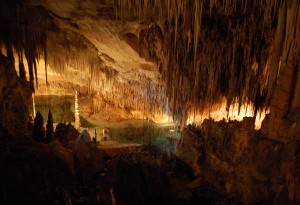A yellow splash of light from Bogdan Onac’s headlamp bounces around the dripping orange walls of a cave like a frenetic firefly. At the other end of the beam, the University of South Florida paleoclimatologist explains that the walls of this cave, on the Mediterranean island of Majorca, have collected a bathtub ring of minerals as brackish water washes in and out. “Majorca is like a Gruyère,” Onac says, its underlying limestone filled with holes just like the cheese. Unlike most coastal cave sites around the world, Majorca sits on a stable tectonic plate and so can serve as a fixed point from which to measure the rise and fall of the sea over time. its caves became encrusted with marine minerals over the course of half a million years. High water marks remain, like graffiti from a changing climate.
A surprise in these cave walls has put Onac at the center of a debate about past sea levels. Encrustations dating back 81,000 years at several of his research sites sit about a meter above present-day sea level, suggesting that’s how much higher the seas were then. This contradicts estimates of past sea levels based on reconstructions of uplifted coastlines in Barbados, New Guinea and elsewhere, which put the sea 8 to 31 meters lower at that time. These estimates help power simulations that show how the planet’s ice cover and sea levels interact. If those inputs are off by tens of meters, then predictions of future sea level rise, like that expected from climate change, will be thrown off as well.
To reconcile the findings, Onac invited a couple dozen of his colleagues to visit the caves last year. Among them was geophysicist Kurt Lambeck of the Australian National University in Canberra, who is using reports of ancient sea level s to build a global model of how ice sheets and sea levels interact. Before the visit, he assumed that Majorcan caves must have risen and fallen more than Onac reported, moving the bathtub up or down and making the rings less reliable. But once inside, Lambeck saw delicate structures called speleothems intact alongside the rings, suggesting little or no vertical movement. He will need more data, but called the cave “difficult to dismiss.”
Onac is now on the hunt for cave samples from a wider time range. He hopes researchers elsewhere will do the same in other coastal caves, eventually translating the writing on the coastal cave walls.
How they do it
To study the history of sea level rise, Bogdan onac and his graduate student Liana Boop examine minerals that were deposited in caves by ancient seas. The researchers gauge the height of the deposits relative to today’s sea level and use the steady decay of radioactivity in the minerals to calculate the deposits’ age to with- in a few hundred years. The deposits may also hold information about ancient rainfall, so Onac and Boop have installed monitoring devices in several Majorcan caves. Data from the devices will show how the water’s conductivity, salinity, acidity, carbon dioxide concentration, temperature, relative humidity and pressure affect the formation of Majorca’s time-telling minerals, aragonite and calcite. The ratio of aragonite to calcite may then help Boop reconstruct how much of a cave’s water came from rain and how much from the sea.
First published in Science News: [html] [iPad edition] [pdf].
Photos from the caves:


